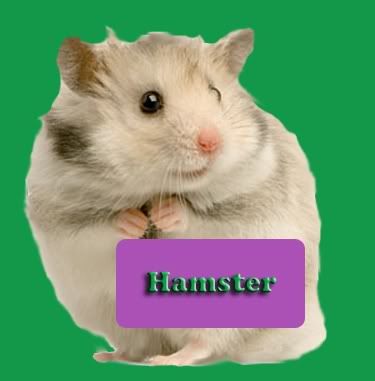
Hamsters are popular pets, and for good reason.
They are easy to care, usually bond well with their owners, and on top of everything else, the are very cute!
Learn about choosing a pet hamster, pet hamster care, and providing all the necessities for your hamster in this handy hamster care guide.
Hamsters make good pets, but they are not the right choice for everyone. There are 3 main types of hamsters.
* Syrian Hamsters - other names include: golden hamsters, teddy bear hamsters (long hair), black bear hamsters (black coat)
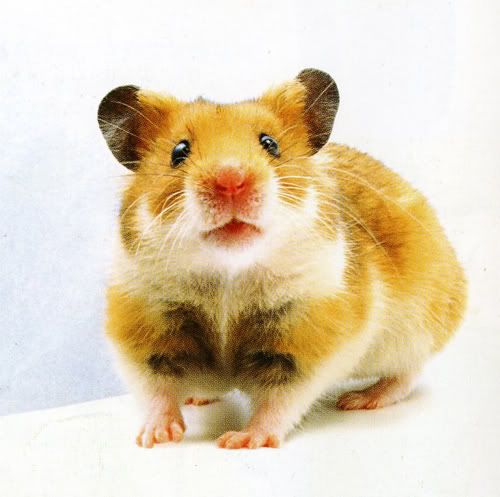
* Dwarf hamsters - includes dwarf Campbells Russian hamster, dwarf winter white Russian hamsters, and Roborovski hamsters
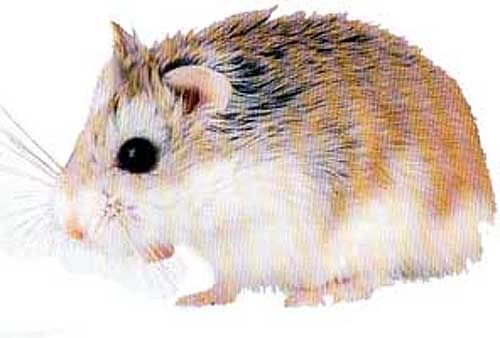
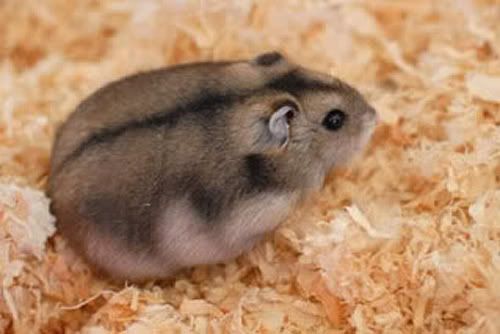

* Chinese Hamsters
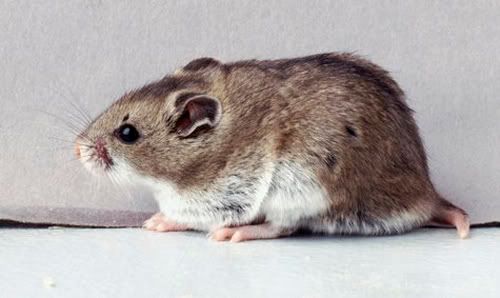
Avoid taking home a hamster that shows common signs and symptoms of illness, stress, or other problems.
While some problems can be hidden, anybody can do a quick check for some common signs of illness or other problems.
While there are no guarantees, avoiding hamsters with obvious signs of problems gives you have the best chance of taking home a healthy hamster.
Since many diseases are contagious, it is safest to also avoid hamsters with cage mates that seem ill.
As an added bonus, you can also get clues about a hamster's temperament while doing a quick health check.
Having a cage all set up and waiting for your hamster is a good way to smooth your hamsters' transition to his or her new home.
There are a huge variety of cage styles and sized out there, and which one to choose can be confusing.
My best advice: don't be fooled by the "coolness" of the cage, and make sure you choose one that is appropriate for the size of hamster you are choosing as well as one that is easy to clean.
Also make sure you have cage accessories such as bedding, an exercise wheel, and a cozy sleep hut picked out.
Here's some tips about choosing supplies:
There are also a lot of choices when it comes to hamster food, and not all are created equal.
Your main choice will be between a pelleted diet and a loose mix (see based) diet, and each has pros and cons.
Your store-bought hamster diet can also be supplemented with a variety of healthy human foods and treat.
Hamsters that haven't been handled may not be happy about being picked up and may try to bite you.
It's important to remember hamsters that bite are not mean -- they are scared and defending themselves the best way they know how.
It may take some patience (and possible some treats) to win your hamster's trust.
Hamsters need to be able to chew, and they need to be able to exercise.
Hamsters really were made to run, so a running wheel is a must. A hamster wheel must be large enough (many hamster wheels are more appropriate for dwarf hamsters than Syrian hamsters), safe (no wire wheels, please), and for your sanity, quiet.
For chewing, a variety of wood structures and toys will help keep your hamster's teeth in shape.
Hamsters also tend to like play tubes and tunnels and things they can climb on.
I don't advocate the casual owner breeding their hamsters -- that is best left to breeders who concentrate on breeding for health and temperament.
However, there are times when accidents happen, including hamsters that weren't separated soon enough at the pet store and come home pregnant.
Also, knowing about hamster reproduction can help prevent accidents in the first place.
Click here for articles on Hamster Care Guide.
" Syrian Hamsters "
Species : Mesocricetus Auratus
Other Names : Golden Hamster, Teddy Bear Hamster (Long Haired), Black Bear Hamster, European Black Bear Hamster, Fancy Hamster, Standard Hamster, Alien Hamster (Hairless)
Expected Life Span : 2.5 - 3.5 Years
Size : 6 - 7 Inches (15 - 17 CM)
Behavior And Temperament : Syrian hamsters are nocturnal but may wake for short times during the day. They generally quite good-natured and easy to tame and handle. They have a reputation for being nippy, but that is usually due to lack of handling or trying to handle them during the day when they would rather be sleeping.
Social Characteristics : Syrian hamsters are solitary and territorial. They should always be housed alone. They may tolerate other hamsters when they are young, but by the time they reach 8 - 10 weeks old, territorial fighting usually starts and may be fatal.
Appearance : The natural coloration of Syrian hamsters is golden brown (technically agouti, meaning the hairs are banded with darker and lighter colors), with a lighter belly. They also have a dark marking on the cheeks, extending from the jaw up toward the ear. Through selective breeding there are a number of variations in colors, lengths, patterns, and coat textures/type. Coats can be classified as below...
• Texture/Type : Rex (Rough Curly), Satin (Glossy), Normal (Matt), Hairless
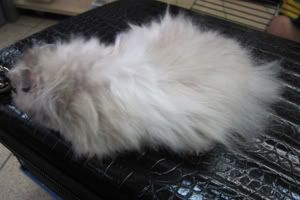
Rex
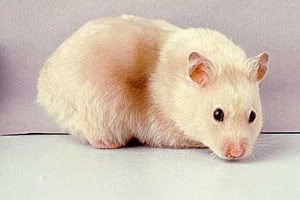
Satin
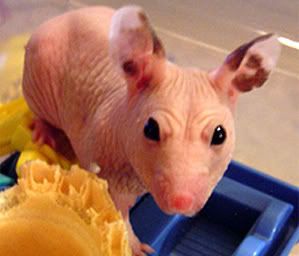
Hairless
• Pattern : Full Colour, Banded (White Stripe Down The Middle), Sable (White Rings Around Eyes), Dominant Spot (Spotted Pattern)
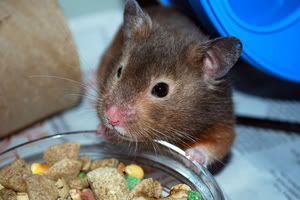
Sable
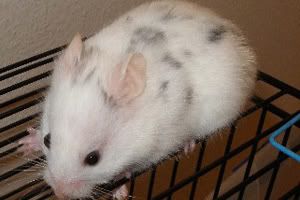
Dominant Spot
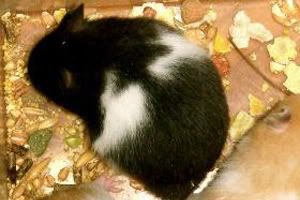
Banded
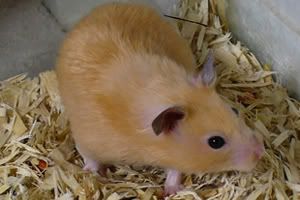
Full Colour
• Length : Short - Long
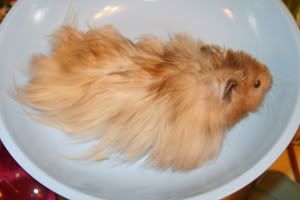
Long Coat
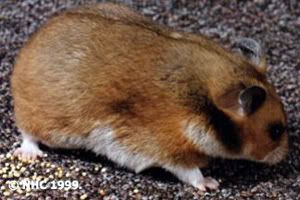
Short Coat
• Colours : Golden, Golden Umbrous, Silver (Grey), Cream, Cinnamon, Chocolate, Black, White, Ivory, Blonde, Copper, Dove, Mink, Smoke Pearl, Beige, Rust, Tri Colour, Yellow, Lilac, Tortiseshell, Rust, Honey...
Notes About Care : Basic care is like that of other hamsters. I usually recommend avoiding modular plastic cages for Syrian hamsters due to concerns with ventilation, size, and ease of cleaning. A simple wire cage or aquarium is preferable. Feed a good quality hamster food supplemented with small amounts of fresh foods.
" Dwarf Winter White Russian Hamsters "
Species : Phodopus Sungorus
Other Names : Siberian Hamster, Siberian Dwarf Hamster, Djungarian Hamster
Expected Life Span : 1.5 - 2 Years
Size : 3.5 - 4 Inches (8 - 10 CM)
Behavior And Temperament : Dwarf winter white Russian hamsters are nocturnal but may be active for short times during the day too. They make good pets, and are generally quite good-natured. Because they are small and quick they can be a challenge to handle, especially for kids.
Social Characteristics : Unlike Syrian hamsters, dwarf winter white Russian hamsters are social with their own species and can be kept in same sex pairs or groupings, but usually only if introduced at a young age. It is not a good idea to introduce adults or new hamsters to a group. Occasionally, hamsters that were raised together may even have to be separated.
Appearance : Dwarf winter white Russian hamsters are normally a dark grey color on their backs with a black dorsal strip along the center of the back. The fur on the belly is white. However, in the winter, the fur can turn white to varying degrees (a change triggered by changes in day length). Selective breeding techniques have produced a few different colours and patterns. Winter white Russian hamsters also have furred feet.

Normal Winter White
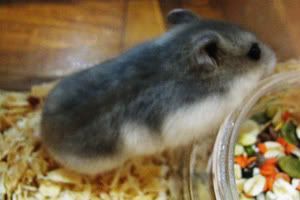
Sapphire Winter White
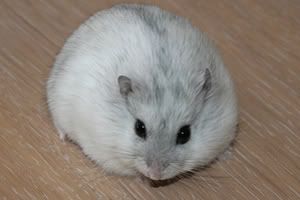
Pearl White Winter White
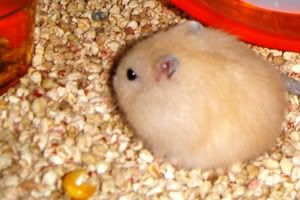
Pudding Winter White
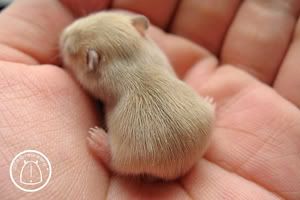
Yellow Blue Winter White
Notes About Care : Basic care is like that of other hamsters. Due to their size, a wire hamster cage may not be escape proof so an aquarium or other solid sided cage with a ventilated but secure top is preferable. Avoid cedar or pine wood shavings, and keep cages well cleaned though to prevent ammonia build-up from accumulated urine as ventilation is diminished with solid sided housing. Feed a good quality hamster food supplemented with small amounts of fresh foods.
" Roborovski Hamsters "
Species : Phodopus roborovskii
Expected Life Span : 3 - 3.5 Years
Size : 1.7 - 2 Inches (4 - 5 CM)
Behavior And Temperament : Roborovski hamsters are nocturnal, waking at dusk and most active at night. They generally quite good-natured and rarely nip, but they are very fast and agile, which makes handling them difficult. It is advisable to handle them in an area where they will be easy to catch if they get away (over a larger box, for example). Because of their speed and agility, a large cage is also necessary to give them room to move about.
Social Characteristics : Roborovski hamsters are social and are ideally kept in single sex (unless breeding) pairs or groupings. This works best if introduced at a young age, though.
Appearance : The natural coloration of Roborovski hamsters is sandy brown on their backs, with a white belly. They also have distinctive white marks over their eyes. A white-faced variety is also seen (the coloration is similar but with a white face).
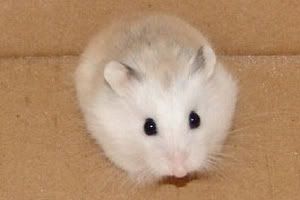
White Faced Roborovski
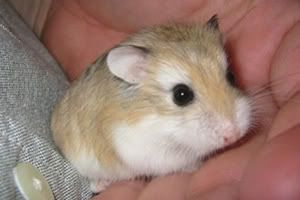
Brown Faced Roborovski
Notes About Care : Basic care is like that of other hamsters. As mentioned above, an aquarium or other solid sided cage with a ventilated but secure top is preferable, the larger the better. Avoid cedar or pine wood shavings, and keep cages well cleaned though to prevent ammonia build-up from accumulated urine as ventilation is diminished with solid sided housing. Feed a good quality hamster food supplemented with small amounts of fresh foods.
" Dwarf Campbell's Russian Hamsters "
Species : Phodopus campbelli
Other Names : Djungarian hamster
Expected Life Span : 1.5 - 2 Years
Size : 4 Inches (10 CM)
Behavior And Temperament : Dwarf Russian Campbell's hamsters are nocturnal but may be active for short times during the day too. They make good pets, but they have a bit of a reputation for nipping if feeling threatened. Because they are small and quick they can be a challenge to handle, especially for kids.
Social Characteristics : Unlike Syrian hamsters, Dwarf Russian Campbell's hamsters are social with their own species and can be kept in same sex pairs or groupings, but usually only if they are introduced at a young age. It is not a good idea to introduce adults or new hamsters to a group. Occasionally hamsters that were raised together may even have to be separated.
Appearance : Dwarf Russian Campbell's hamsters normally have grey-brown fur on their backs with a darker dorsal strip along the center of the back. The fur changes to a creamy color on the sides and whiter on the belly. However, selective breeding techniques have produced Campbell's hamsters in a wide variety of coat colours and patterns. Campbell's hamsters are also noted for having furred feet.
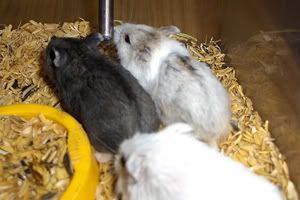
Different coloured and patterned Campbell's Hamsters
Notes About Care : Basic care is like that of other hamsters. As mentioned above, a wire hamster cage may not be escape proof so an aquarium or other solid sided cage with a ventilated but secure top is preferable. Avoid cedar or pine wood shavings, and keep cages well cleaned though to prevent ammonia build-up from accumulated urine as ventilation is diminished with solid sided housing. Feed a good quality hamster food supplemented with small amounts of fresh foods.
" Chinese Hamsters "
Species : Cricetus Griseus
Other Names : Striped Hamster, Chinese Striped Hamster
Expected Life Span : 1.5 - 2 Years
Size : 4 Inches (10 CM)
Behavior And Temperament : Chinese hamsters are nocturnal but may be active for short times during the day too. They are somewhat timid but are generally quite good-natured and rarely nip. Because they are so small and quick they can be a real challenge to handle, though, especially for kids. They are very active and require a large cage to prevent boredom.
Social Characteristics : There is some disagreement among experts on this point. As they mature, Chinese hamsters, especially females, may become quite aggressive with others and may need to be separated. However, other owners have managed to keep them in pairs or groupings, which requires a fair amount of space (and only if introduced at a young age). To be on the safe side, plan on housing Chinese hamsters separately, only keeping them together if they show no signs of aggression.
Appearance : The natural coloration of Chinese hamsters is agouti (hairs are banded with light and dark colors), with a dark brown color on their backs, a black dorsal line (along their spine), and ivory colored bellies. The only other pattern seen is a Dominant Spot (white coat with patches or spots of color). Chinese hamsters have a tail, about an inch long and hairless. Sometimes these are called rat-like or mouse-like hamsters due to their slender appearance and the fact that they have a tail.

Notes About Care : Basic care is like that of other hamsters. As mentioned above, a wire hamster cage may not be escape proof so an aquarium or other solid sided cage with a secure top is preferable, the larger the better. Avoid cedar or pine wood shavings, and keep cages well cleaned though to prevent ammonia build-up from accumulated urine as ventilation is diminished with solid sided housing. Feed a good quality hamster food supplemented with small amounts of fresh foods.
Additional Note : Chinese hamsters are not very commonly bred and can be hard to find. They are also restricted in some places, such as the state of California where a permit is required to keep them.